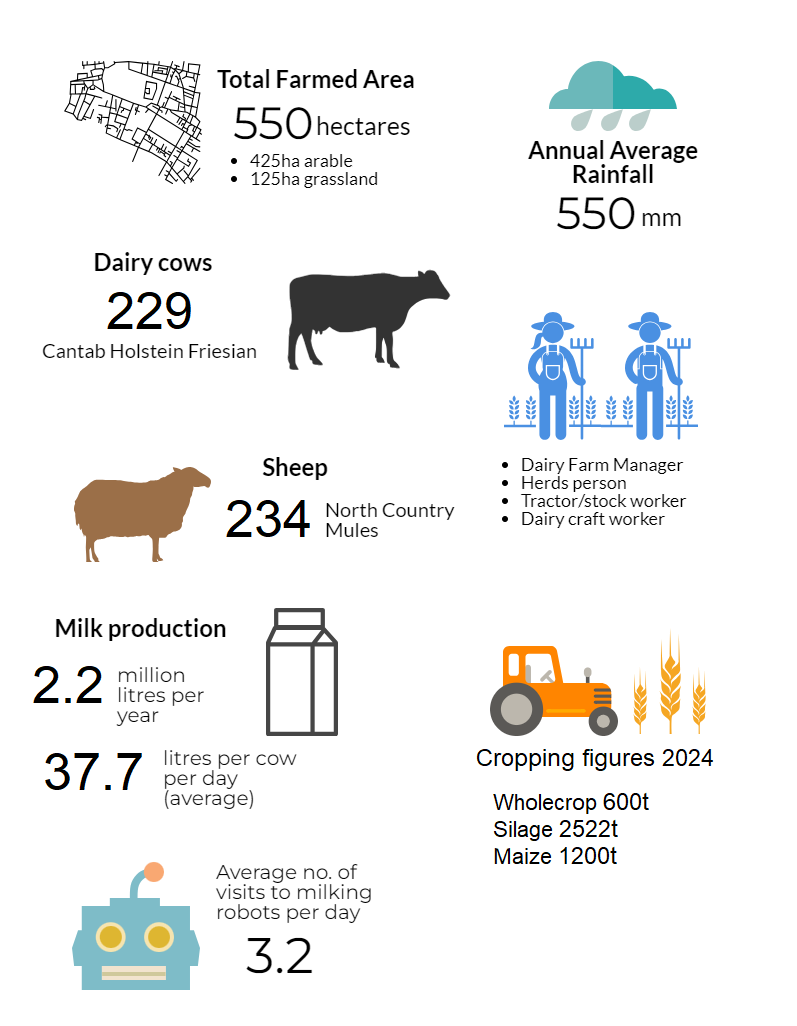About the Farm
History
Cambridge University Farm was originally established at Impington in 1900, just after the establishment of a Department of Agriculture at Cambridge. In 1910 the farm moved to Gravel Hill, just off Huntingdon Road, where it remained until 1997, when it relocated once again to Park Farm, Madingley in order to release land for the West and North West Cambridge developments.
The Department of Agriculture closed in 1972 and the farm became part of the Department of Applied Biology. The University Farm is now a commercial business, owned by the University of Cambridge and operated as part of the Estates Division.
The University Farm is home to the Cantab herd of pedigree Holstein Friesian cows and a flock of predominantly Scotch mules sheep.
Aims
The aims of the University Farm are to:
- Provide a teaching resource to the Department of Veterinary Medicine.
- Manage livestock operations in ways that demonstrate animal welfare best practice and produce high quality outputs.
- Farm in a sustainable manner, including maintaining and enhancing the conservation value of the farm.
- To manage the farm as commercially as possible without conflicting with the other objectives.
- Manage the land bank around Cambridge and release it for academic or other uses when required by the University.
Cambridge University Farm (CUF) aspires to be an exemplar centre for teaching, animal welfare and the production of high quality outputs, benefiting the broader student experience by giving veterinary students exposure to good or best practice which, where possible, is supported by CUF demonstrating that this is to the benefit of the farmer.
Location
The map below shows the location of Park Farm, Madingley, where the main farming operations are based.
Please allow social and marketing cookies to show embedded content.
Operations and Extent
The Farm comprises the following enterprises.
- A total farmed area of 550ha, made up of 425ha arable land and 125ha grassland.
- Dairy Unit of c.220 Cantab Holstein Friesian cows, with c.190 of these providing milk at any point in time. The farm produces approximately 2.3 million litres of milk annually, which is an average of 37.7 litres per cow per day, with 3.2 visits to milking robots a day on average.
- The management of c.175 heifers (birth to 2 years) who are our dairy cows of the future.
- A sheep flock of c.250 Scotch mules, with c.350 lambs finished for market.
- Forage production from permanent pasture, temporary grass leys, maize and oat whole crop to support the livestock enterprises.
- Combinable cropping of c.260ha that provides grains, pulses and oilseeds for sale and feed, and straw for the livestock enterprises. 2024 saw 600t of wholecrop, 2522t of silage and 1200t of maize.
- Annual average rainfall of 550mm.
- Staff include a Dairy Farm Manager, herdsperson, tractor/stock worker and dairy craft worker.
Figures in image accurate from October 2024.
The large-scale keeping of livestock in Cambridgeshire is unusual, but necessary to provide adequate teaching material for the Department of Veterinary Medicine.
The soils at the farm predominately comprise clay soils of grade 3 and 2 soils, which are classified by Cranswick as being Soilscape 9.
The land farmed includes Madingley Park, a registered Park and Garden, originally designed and set out by Capability Brown 300 years ago, and still forming the backdrop to Madingley Hall, which is now occupied by the University's Professional and Continuing Education.
The Farm is the principal occupier of the University's Rural Estate, that also includes 89ha of woodland, including Madingley Wood Site of Special Scientific Interest (15.4hectares) and the 800 Wood (10 hectares), planted with over 15,000 trees to commemorate the 800th anniversary of the formation of the University of Cambridge.
Industry relations
- Supporting the Department of Veterinary Medicine
- Hosting on-farm public and knowledge transfer events
- Work closely with Volac on calf performance and assist with development of new technology/practices.
- Sustainable farming organisation LEAF (Linking Environment and Farming) named the Farm as a Demonstration Farm, in recognition of its commitment to reducing the carbon footprint of its dairy enterprise.
